Can a simple visualisation technique unlock your cognitive abilities and change how you think? The answer is yes, through mind mapping. This tool has been changing how we solve problems and think creatively.
By using visual thinking, you can unlock your creative potential. It helps you connect ideas that might seem unrelated. This method boosts your cognitive skills, memory, and productivity.
Key Takeaways
- Discover the benefits of using visual thinking to enhance cognitive abilities.
- Learn how to harness the power of mind mapping to improve creativity and productivity.
- Understand the significance of cognitive mapping in unlocking your mind’s potential.
- Explore the role of mental mapping in organising and connecting ideas.
- Unlock your full potential by applying mind mapping techniques to your daily life.
Table of Contents
- The Power of Mind Mapping Explained
- The History and Evolution of Mind Mapping
- The Science Behind Mind Mapping
- Key Benefits of Mind Mapping Techniques
- Different Types of Mind Maps for Various Purposes
- How to Create Effective Mind Maps: A Step-by-Step Guide
- Essential Tools for Mind Mapping
- What is mind mapping, and how does it work?
- What are the benefits of using mind mapping for brainstorming and problem-solving?
- Can mind mapping be used for note-taking and studying?
- What are the different types of mind maps, and how are they used?
- What tools are available for creating mind maps, and which ones are recommended?
- Can mind mapping be used for personal and professional development?
- How can I get started with mind mapping, and what are the essential steps to create an effective mind map?
The Power of Mind Mapping Explained
Mind mapping uses visual thinking to help people organise their thoughts better. It works by tapping into the brain’s love for visual information. This makes it simpler to come up with, sort, and remember ideas.

The Concept Behind Visual Thinking
Visual thinking is how our brains use images and layouts to understand and arrange information. It’s based on the idea that our brains are better at handling pictures than words. Mind maps use visual elements like colours and shapes to connect with this natural ability. This boosts creativity and helps us grasp complex ideas more easily.
Mind Maps vs. Traditional Note-Taking
Mind maps are different from traditional note-taking because they’re not just text. They’re a visual way to capture and sort out information. This makes it easier to see how different ideas are connected. Using mind maps as a creativity technique can greatly improve brainstorming and problem-solving skills.
The History and Evolution of Mind Mapping

The story of mind mapping is both fascinating and full of innovation. It started with visual thinking and has grown into the digital tools we use today. This journey shows how mind mapping has evolved over time.
The Birth of Modern Mind Mapping
Tony Buzan, a British psychologist, made mind mapping popular in the 1970s. He took existing ideas and made them clearer and more accessible. His use of colour, images, and keywords helped mind maps become a key tool for note-taking and idea creation.
Evolution in the Digital Age
Digital technology has changed mind mapping a lot. Tools like MindMeister and XMind let us create detailed maps easily. We can also work together in real-time and access our maps on different devices. This digital shift has made mind mapping more useful for both personal and work projects.
| Era | Key Developments | Notable Figures |
|---|---|---|
| Pre-Digital | Hand-drawn maps, limited to physical media | Tony Buzan |
| Digital | Software applications, real-time collaboration | MindMeister, XMind developers |

The Science Behind Mind Mapping
Mind mapping is based on how our brains work. It’s not just a pretty way to sort out information. It’s deeply connected to how we process and keep data.
Alignment with Natural Brain Function
Mind maps reflect the brain’s natural setup. They have a central idea with branches, like our brain’s neural networks. This makes thinking and learning easier. Studies show our brains like visual stuff, making mind maps great for cognitive mapping and keeping info.
Cognitive Benefits of Visual Organisation
Mind maps have many cognitive perks. They boost memory improvement by linking new info to pictures and places. They also help with decision making by showing different choices and their effects. This makes it simpler to compare and choose.
| Cognitive Benefit | Description |
|---|---|
| Enhanced Memory | Mind maps associate new information with visual and spatial cues, improving retention. |
| Better Decision Making | Visual representation of options and outcomes facilitates easier comparison. |
| Improved Organisation | Information is structured in a logical, visually appealing manner. |
Mind maps tap into the brain’s natural ways. They’re a strong tool for bettering our thinking, from memory improvement to smarter decision making.
Key Benefits of Mind Mapping Techniques
Mind mapping helps us organise information in a visual way. It’s great for improving memory, solving problems, and boosting creativity. This method is widely used because it makes our brains work better.
Enhanced Memory Retention and Recall
Mind mapping makes it easier to remember things by making them visually appealing. It uses colours, images, and keywords to get our brains working. This way, we can remember information better than if it was just text.
Improved Problem-Solving Capabilities
Mind mapping is a top tool for solving problems. It helps us break down big issues into smaller parts. This way, we can see patterns and find solutions more easily.
Boosted Creativity and Innovation
Mind mapping is a creative way to think. It lets us explore ideas freely, without being stuck in one way of thinking. This helps us find new and interesting connections between different ideas.
| Benefits | Description | Impact |
|---|---|---|
| Enhanced Memory Retention | Visual organisation of information | Improved recall and memory |
| Improved Problem-Solving | Breaking down complex issues | Effective identification of solutions |
| Boosted Creativity | Free flow of ideas | Increased innovation |
Different Types of Mind Maps for Various Purposes
Mind maps are versatile tools with many forms. Each is designed for a specific purpose to improve our thinking. They help us understand complex information, come up with new ideas, or plan strategically.
Concept Maps for Understanding Complex Relationships
Concept maps are great for showing how different ideas are connected. They help us organise information in a clear way. This makes it easier to understand and study complex topics.
Idea Maps for Effective Brainstorming
Idea maps are perfect for brainstorming and coming up with new ideas. They offer a flexible, non-linear way to think. This helps us quickly jot down our thoughts and spot connections we might miss otherwise.
Strategic Maps for Planning and Decision Making
Strategic maps are used for planning and making decisions. They let us outline our goals and actions clearly. This is especially useful in work settings, helping teams work together and make smart choices.
How to Create Effective Mind Maps: A Step-by-Step Guide
To get the most out of mind mapping, follow a clear guide. It boosts creativity and keeps things organised. Mind maps help you see your thoughts and ideas in a visual way.
Starting with a Central Idea
A good mind map starts with a clear central idea. Place it at the map’s centre. It’s the base for all your branches.
For example, if you’re planning a project, your central idea could be “Launch a New Product” or “Plan a Marketing Campaign.” Make sure it’s clear and focused.
Building Branches and Sub-branches
After setting your central idea, create branches that spread out from it. These branches should cover the main points related to your idea. Use short words and phrases to label them, aiming to spark memory and creativity.
As you grow your map, add sub-branches for more details. This structure makes complex info easier to understand.
Using Colours, Images, and Keywords
Colours, images, and keywords make your mind map lively and useful. Use colours to show different themes or highlight key points. Add images and icons to make it more engaging and creative.
Choose keywords that are short and to the point. They should capture the essence of your ideas. Avoid long sentences or descriptions.
Refining and Expanding Your Mind Map
Keep improving your mind map by rearranging branches and adding new info. Feel free to try different layouts until you find one that suits you best.
Here’s a comparison to show mind mapping’s benefits:
| Feature | Mind Mapping | Traditional Note-taking |
|---|---|---|
| Visual Organisation | Highly visual, using colours and images | Primarily text-based |
| Creativity Stimulation | Encourages creativity through free-form expression | Limited by linear structure |
| Information Recall | Facilitates easy recall through visual cues | Relying on text, can be more challenging |
By following these steps and using colours, images, and keywords, you can make effective mind maps. They enhance brainstorming and improve mental imaging.
Essential Tools for Mind Mapping
Mind mapping is a flexible technique that can be improved with the right tools. You can choose from digital and traditional tools, depending on your preference and needs.
Digital tools like MindMeister and Coggle are great for team brainstorming. They offer many templates and ways to customize, making mind mapping easier.
If you like working with your hands, traditional materials are perfect. Coloured pens, sticky notes, and large sheets of paper are great for creating mind maps. They offer a hands-on, creative way to work.
When picking a mind mapping tool, think about what you need for your project. Whether it’s a digital tool for brainstorming or a way to organize your ideas, there’s something for everyone.
Using these essential tools can help you get the most out of mind mapping. It can boost your productivity and creativity.
What is mind mapping, and how does it work?
Mind mapping is a way to visually connect ideas and information. It starts with a central idea and then branches out. These branches link related info, using colours, images, and keywords to help remember and understand better.
What are the benefits of using mind mapping for brainstorming and problem-solving?
Mind mapping boosts brainstorming and problem-solving. It lets you see ideas and connections clearly. This can spark creativity, improve decision-making, and find better solutions.
Can mind mapping be used for note-taking and studying?
Yes, mind mapping is great for notes and studying. It helps you remember and recall information better. You can also see how ideas relate to each other and review material more easily.
What are the different types of mind maps, and how are they used?
There are many types of mind maps. Concept maps help understand complex relationships. Idea maps are for brainstorming. Strategic maps are for planning and making decisions.
What tools are available for creating mind maps, and which ones are recommended?
Many tools can help make mind maps. Digital tools like MindMeister and Coggle are popular. Traditional options include paper, pens, and coloured pencils. The best tool depends on what you prefer and need.
Can mind mapping be used for personal and professional development?
Yes, mind mapping helps with personal and professional growth. It aids in setting goals, planning projects, and organising thoughts. This leads to better productivity and success in many areas of life.
How can I get started with mind mapping, and what are the essential steps to create an effective mind map?
Start by picking a central idea or concept. Then, add branches to link related info. Use colours, images, and keywords to make it more engaging. Keep refining and expanding your map. Regular practice will improve your skills.




